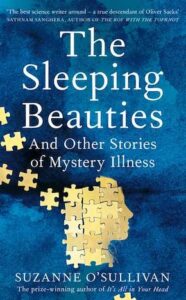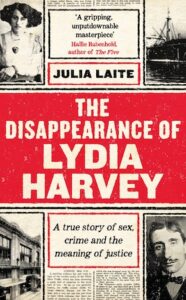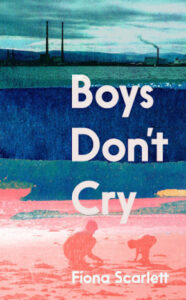Lost souls
by Sonia Weir
“A travelogue of illness that is ultimately a travelogue of our own irrational, suggestible minds.” The Times
Suzanne O’Sullivan’s The Sleeping Beauties (Picador) is utterly fascinating. It reminds us that the brain is a wonderful and powerful thing and we have a long way to go before understanding it fully. Suzanne, a consultant in neurology, delves into cases that doctors and scientists have struggled to explain. Why are refugee children in Sweden falling asleep for months at a time? Why do US employees in the recently reopened embassy in Cuba complain of headaches and loud noises? And why do people in a dying town in Kazakhstan keep falling asleep and have seizures?
She sets out to explore all these cases and to try and understand them from a more holistic point of view. They are all types of psychosomatic illness, and rather than find a reason within the person Suzanne looks beyond, into their community and culture, to question whether outside factors have a bigger part to play in the person’s illness. Are the refugee children falling asleep because they don’t feel welcome and think that life would be easier if they were not around? Are they taking on the stress of their parents?
A group of girls in Colombia start to faint in school, most probably due to a hot room. When that fact is dismissed for the untruth that the HPV vaccine is to blame, this prompts more fainting girls. The parents want an explanation, and this is an easy one to hold onto even though there is no evidence.
When a case of psychosomatic illness breaks out in a country in South America the community often rallies round to support those affected and eventually the problem disappears. In the Western world things are different, there is a need for it to be medicalised and given a name. She argues that we over-test and tend to label things to be easily digestible for the patient even though this can be detrimental to their health.
The physical symptoms these patients experience are very real and can be a cry for help. The best chance of recovery comes from a community that will listen without judgement and offer support. I found the cases in this book deeply moving, and it really made me think about how we define illness and how as a society we can come together to support one another.
In the panic of ‘white slavery’, countries used the crime as an excuse for anti-immigration laws, detention and punishment. You can still see this happening in today’s society.”
In The Disappearance of Lydia Harvey (Profile Books), historian Julia Laite tells the extraordinary story of a victim of ‘white slavery’, which was rife in the early 1900s. As it is today, sex trafficking was huge and global. Men would lure young girls with a promise of travel and a glamorous lifestyle instead of the only other options available to them, either marriage or domestic servitude.
Lydia had a desire for a better life than the one she was living in New Zealand. At sixteen she meets a couple who promise her the world. She travels to Argentina, where she is forced into a life of prostitution. She eventually ends up in London where she becomes a star witness at a trial of traffickers.
Julia Laite has done an amazing job researching and piecing together the life of Lydia. It reads like a thriller. Each chapter is told from the view of the people who were involved. It’s a great insight into the workings of the police and how they dealt with international crime and the way traffickers did their business.
Her rescuer, Eilidh MacDougall, dedicated her life to helping the victims of the sex trade and became the first woman to take up a voluntary role at the Metropolitan Police Home for Women and Girls. She was the first of her kind, a prototype social worker.
There are so many parallels with the modern world. In the panic of ‘white slavery’, countries used the crime as an excuse for anti-immigration laws, detention and punishment. You can still see this happening in today’s society. The continued lack of empathy for trafficked women and girls is very evident, and there is still such a thin line between them being judged a criminal or a victim. A fascinating exploration into the lives of women in the early twentieth century that really makes you realise how little has changed.
This book really packs an emotional punch, and even though the subject matter is bleak there is humour along with hope.”
Irish writer Fíona Scarlett’s tender debut novel Boys Don’t Cry (Faber & Faber) will stay with you for a very long time. A moving story of two brothers growing up on a housing estate in Dublin, it’s a book about grief, family and above all else love. Even though the writing is sparse there is a whole lot of feeling packed into the pages of this short novel.
The dual narrative tells the story of Joe and Finn growing up in a tower block. Joe is determined not to become like their imprisoned father, who worked for a notorious gangster. He has an arts scholarship at a private school, but when Finn becomes ill Joe begins to get sucked into the life that he swore he would never enter.
The chapters told through the eyes of Finn are the most heartbreaking. At only 12 he is trying to make sense of his illness and its consequences. The bond with his brother is so strong as they both try to protect each other from their own realities.
I really enjoyed the descriptions of the housing estate and the characters that live there. The dialogue flows with vivid reality and ease. I really cared what happened to these two boys and the community they live in. This book really packs an emotional punch, and even though the subject matter is bleak there is humour along with hope. It shows us that through loss and darkness we can eventually find the light and take comfort in our memories.
Sonia Weir is a contributing editor to Bookanista. She started the Ultimate Reads and Recommendations Facebook group in December 2018, which now has over 500 members from all over the world. The group is inclusive and aimed at every reader, no matter the books, authors or genre.
Ultimate Reads and Recommendations
Instagram @soniaweir
Twitter @soniaweir



